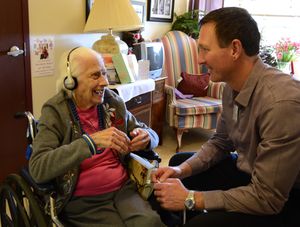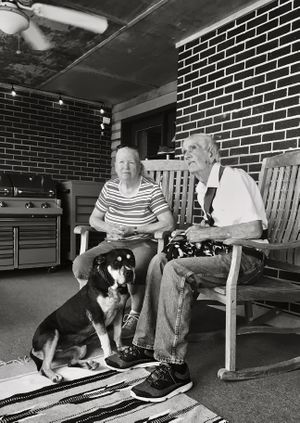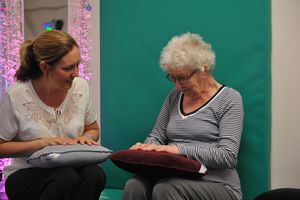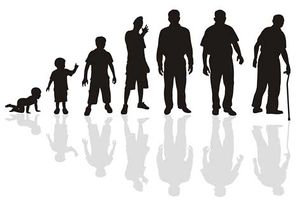Older People - Patterns of Illness, Physiological Changes and Multiple Pathology: Difference between revisions
Evan Thomas (talk | contribs) mNo edit summary |
No edit summary |
||
| (41 intermediate revisions by 6 users not shown) | |||
| Line 3: | Line 3: | ||
'''Top Contributors''' - {{Special:Contributors/{{FULLPAGENAME}}}} | '''Top Contributors''' - {{Special:Contributors/{{FULLPAGENAME}}}} | ||
</div | </div> | ||
< | == Introduction == | ||
[[File:Old Man.jpeg|right|frameless]]Ageing is a natural process. Everyone must undergo this phase of life at his or her own time and pace. In the broader sense, ageing reflects all the changes taking place over the course of life<ref name=":0">Amarya S, Singh K, Sabharwal M. [https://www.intechopen.com/books/gerontology/ageing-process-and-physiological-changes Ageing process and physiological changes.] InGerontology 2018 Jul 4. IntechOpen.Available from:https://www.intechopen.com/books/gerontology/ageing-process-and-physiological-changes (accessed 10.4.2021)</ref>. | |||
< | Physiological changes occur with ageing in all organ systems. | ||
* The cardiac output decreases, [[Blood Pressure|blood pressure]] increases and [[Atherosclerosis|arteriosclerosis]] develops. | |||
* The [[Lung Anatomy|lungs]] show impaired gas exchange, a decrease in vital capacity and slower expiratory flow rates. | |||
* The creatinine clearance decreases with age although the serum creatinine level remains relatively constant due to a proportionate age-related decrease in creatinine production. Creatinine is a waste product in the blood that comes from normal muscle wear and tear. If kidney function declines, creatinine levels in the blood rise.<ref>Emedicine health Creatinine Blood Tests Available:https://www.emedicinehealth.com/creatinine_blood_tests/article_em.htm (accessed 31.8.2022)</ref>See [[Renal Function Test (RFT)|Renal Function Test]] | |||
* Functional changes, largely related to altered motility patterns, occur in the gastrointestinal system with senescence, and atrophic gastritis and altered hepatic drug metabolism are common in the elderly. | |||
* [[Immunosenescence]] (the changes in immune function) contribute to the increased sensitivity to disease in older people. | |||
* Progressive elevation of blood glucose occurs with age on a multifactorial basis. The decline in glucose tolerance from 17–39 years to 40–59 years is explained by the secondary influences of body fat and physical fitness. Even so, changes in glucose tolerance that occur between 60 and 92 years are notable and are unexplained when body composition and physical activity are accounted.<ref>Chia CW, Egan JM, Ferrucci L. Age-related changes in glucose metabolism, hyperglycemia, and cardiovascular risk. Circulation research. 2018 Sep 14;123(7):886-904.Available:https://www.ahajournals.org/doi/10.1161/CIRCRESAHA.118.312806#d3e1471 (accessed 31.8.2022)</ref> | |||
* [[Osteoporosis]] is frequently seen due to a linear decline in bone mass after the fourth decade. | |||
* The epidermis of the [[skin]] atrophies with age and due to changes in [[collagen]] and elastin the skin loses its tone and elasticity. | |||
* [[Body Composition|Lean body mass]] declines with age and this is primarily due to loss and atrophy of [[Muscle Cells (Myocyte)|muscle cells]] [[Sarcopenia|(sarcopenia]]) | |||
* Degenerative changes occur in many joints and this, combined with the loss of muscle mass, inhibits elderly patients' locomotion. | |||
These changes with age have important practical implications for the clinical management of [[Older People - An Introduction|elderly]] patients: metabolism is altered, changes in response to commonly used drugs make different drug dosages necessary and there is need for rational preventive programs of diet and exercise in an effort to delay or reverse some of these changes<ref>Boss GR, Seegmiller JE. [https://pubmed.ncbi.nlm.nih.gov/7336713/ Age-related physiological changes and their clinical significance.] Western Journal of Medicine. 1981 Dec;135(6):434.Available from: https://pubmed.ncbi.nlm.nih.gov/7336713/<nowiki/>(accessed 10.4.2021)</ref>. | |||
== Morbidity and Ageing == | |||
<div class="discussionpointbox">[[File:Dementia 2.jpg|right|frameless]]As older age degenerative problems become pre-eminent and much of health care practice falls within the category of chronic conditions and in many of these conditions, by the time they manifest themselves a successful cure is elusive. Distinguishing the accumulation of age related disease (morbidity) from true ageing is difficult<ref>Izaks G and Westendorp R (2003). [https://bmcgeriatr.biomedcentral.com/articles/10.1186/1471-2318-3-7 Ill or just old? Towards a conceptual framework of the relation between ageing and disease]. BMC Geriatrics, 3(7). www.biomedcentral.com/1471-2318/3/7</ref>.</div>Commonly seen conditions are liable to be disregarded by the individual, relatives or by the doctor as they develop slowly. Eg | |||
* Gradual onset of alterations in voice, in facial appearance, cold sensitivity, lethargy and slowing may be easily attributable to the ageing process that myxoedema (decreased activity of the [[Hypothyroidism|thyroid]] gland) can be overlooked. | |||
* Postural changes, stiffness and restricted activity often considered a part of ageing may cause the rigidity and bradykinesia of [[Parkinson's - Clinical Presentation|Parkinson’s]] to be missed. | |||
Investigations are often provoked due to comments from a visitor, especially one who has not seen the person for a long time and to whom the changes are noticeable. | |||
[[File:Old couple.jpeg|right|frameless]] | |||
== Physiological Changes in Older Adults == | |||
Read the great Links | |||
[[Cardiovascular Considerations in the Older Patient]] | |||
[[Ageing and the Cardiorespiratory System]] | |||
[[Muscle Function: Effects of Aging|Muscle Function: Effects of Ageing]] including [[Sarcopenia]] | |||
[[Ageing and the Locomotor System]] | |||
[[Effects of Ageing on Bone|Effects of Ageing on Bones]] including [[Osteoporosis]] | |||
[[Effects of Ageing on Joints]] | |||
[[Ageing and the Special Senses]] | |||
[[Ageing and the Central Nervous System: Brain and Spinal cord|Ageing and the Central Nervous System]] | |||
[[Ageing and the Brain]] | |||
== Body composition changes in old age == | |||
* The human body is made up of fat, lean tissue (muscles and organs), bones and water. After the age of 40, [[Body Composition|body composition]] starts changing, losing their lean tissue. Body organs like liver, kidneys and other organs start losing some of their cells. This decline in muscle mass is associated with weakness, disability and morbidity | |||
* Height loss is associated with ageing changes in the bones, muscles and joints. People typically lose about 1 cm every 10 years after age 40. Height loss is even more rapid after age 70. These changes can be prevented by following a healthy diet, staying physically active and preventing and treating bone loss. | |||
* Changes in the total body weight vary for men and woman, as men often gain weight until about age 55 and then begin to lose weight later in life. This may be related to a drop in the male sex hormone testosterone. Women usually gain weight until age 67–69 and then begin to lose weight. Studies have also shown that older people may have almost one-third more fat compared to when they were younger. Fat tissue builds up towards the centre of the body, including around the internal organs<ref name=":0" /> | |||
== Vestibular system == | |||
* The [https://physio-pedia.com/Vestibular_System vestibular system] entails vestibular nerve, [[brainstem]] and [[Cerebellum|cerebellar]] processing circuits and this system in germane in postural [[balance]], self motion and spatial orientation<ref name=":3">Allen D, Ribeiro L, Arshad Q, Seemungal BM. Age-related vestibular loss: [https://www.ncbi.nlm.nih.gov/pmc/articles/PMC5165261/ Current understanding and future research directions.] Frontiers in Neurology. 2017 Aug 21;7:231.</ref>. | |||
* Ageing physiological changes in the [https://physio-pedia.com/Vestibular_System vestibular system] may lead to a greater [[Falls in elderly|falls]] risk.<ref name=":3" /> | |||
* Physiological change in the [https://physio-pedia.com/Vestibular_System vestibular system] of older adults may explain dizziness and imbalance, benign positional paroxysmal vertigo among older adults<ref>Iwasaki S, Yamasoba T. [https://www.ncbi.nlm.nih.gov/pmc/articles/PMC4306472/ Dizziness and imbalance in the elderly: age-related decline in the vestibular system]. Aging and disease. 2015 Feb;6(1):38.</ref>. | |||
[[File:MSE Dementia pic.jpg|right|frameless]] | |||
''' | == Altered Responses to Illness == | ||
* Illnesses often present differently in old age than in youth. | |||
* Regulation of body temperature is unstable or less responsive, so pyrexia may not be as marked as would be expected even in severe infections such as pneumonia, appendicitis or pyelonephritis. | |||
* A lack of awareness of cold, or of the capacity to react normally to it, may lead to hypothermia | |||
* '''[[ICU Delirium|Delirium]]''' precipitating factors including immobility, malnutrition, inter-current illness, dehydration and, stress of admission to hospital or other unfamiliar settings<ref>Elie M, Cole MG, Primeau FJ, Bellavance F (1998). [https://www.ncbi.nlm.nih.gov/pubmed/9541379 Delirium Risk Factors in Elderly Hospitalized Patients.] J Gen Intern Med; 13(3): 204–212</ref>. | |||
''' | == Pain == | ||
* '''[[Pain Behaviours|Pain]]''' is common in older people. However as people age, they complain less of pain. The reason may be a decrease in the body's sensitivity to pain or a more stoical attitude toward pain. | |||
* Some older people mistakenly think that pain is an unavoidable part of ageing and thus minimize it or do not report it. | |||
* In conditions that cause intense pain in earlier life (e.g. angina or [[Fracture|fractures]]), there may be so little discomfort, or pain is referred in such a bizarre way, that diagnosis is delayed – sometimes with fatal consequences. | |||
* Pain is often not correctly recognized and treated in people with [[dementia]], and use of a scale such as the [[Abbey Pain Scale|Abbey pain scale]] may help to recognize when a person is in pain. | |||
== Response to Drugs == | |||
*[[File:Pill banner.png|right|frameless|500x500px]][[Polypharmacy|Poly-pharmacy]] is a common phenomenon among the older adults and this is because ageing is a risk factor for many chronic conditions. | |||
* Physiological changes in older adults and polypharmacy contribute to adverse drug reactions seen in older adults.<ref>Corsonello A, Pedone C, Incalzi RA. [https://www.ingentaconnect.com/content/ben/cmc/2010/00000017/00000006/art00005 Age-related pharmacokinetic and pharmacodynamic changes and related risk of adverse drug reactions]. Current medicinal chemistry. 2010 Feb 1;17(6):571-84.</ref>. It has been claimed that the adverse drug reaction in older adults is due to increased pharmacodynamic sensitivity and a prescription error.<ref>Brahma DK, Wahlang JB, Marak MD, Sangma MC. [https://www.ncbi.nlm.nih.gov/pmc/articles/PMC3669588/ Adverse drug reactions in the elderly]. Journal of pharmacology & pharmacotherapeutics 2013 Apr;4(2):91.</ref> | |||
* When prescribing drugs to older adults, their physiological responses to these drugs need to be considered. | |||
== Recovery from Illness == | |||
* Due to physiological changes seen in older adults as a result of aging, recovery becomes slowed once they become ill. | |||
* Older adults rarely recover to their baseline in functional activities of daily living after acute medical illness. | |||
* There seems to be association between heart rate recovery and performance<ref>Keary TA, Galioto R, Hughes J, Waechter D, Spitznagel MB, Rosneck J, Josephson R, Gunstad J. [https://www.hindawi.com/journals/cpn/2012/392490/#results Reduced heart rate recovery is associated with poorer cognitive function in older adults with cardiovascular disease.] Cardiovascular psychiatry and neurology. 2012;2012.</ref>. | |||
* Aging effects on both the cardiovascular system and cognitive performance may explain some of the reasons why older adults may be slowed to recover from illness<ref>Boyd CM, Landefeld CS, Counsell SR, Palmer RM, Fortinsky RH, Kresevic D, Burant C, Covinsky KE. [https://onlinelibrary.wiley.com/doi/abs/10.1111/j.1532-5415.2008.02023.x Recovery of activities of daily living in older adults after hospitalization for acute medical illness.] Journal of the American Geriatrics Society. 2008 Dec;56(12):2171-9.</ref>. | |||
[[File:Life-stages.jpg|right|frameless]] | |||
== Conclusion == | |||
* In recent years with a rising percentage of elderly population, epidemiologists, researchers, demographers and clinicians have focussed their attention towards elderly care health issues and various problems associated with ageing and numerous implications of this demographic transition. | |||
* Elderly face various problems and require a multi-sectoral approach involving inputs from various disciplines of health, psychology, nutrition, sociology and social sciences. | |||
* '''See also [[Perceptions about Ageing and Ageism|Perceptions about Ageing and Ageism]] ''' | |||
</ | |||
< | |||
''' | |||
== References == | == References == | ||
| Line 84: | Line 90: | ||
<references /><br> | <references /><br> | ||
[[Category:Older_People/Geriatrics]] [[Category:Global_Health]] | [[Category:Older_People/Geriatrics]] | ||
[[Category:Global_Health]] | |||
[[Category:Occupational Health]] | |||
[[Category:Older People/Geriatrics - Conditions]] | |||
[[Category:AGILE Project]] | |||
[[Category:Physiology]] | |||
Latest revision as of 09:32, 31 August 2022
Original Editor - Bhanu Ramaswamy as part of the AGILE Project.
Top Contributors - Admin, Lucinda hampton, Kim Jackson, Tolulope Adeniji, Evan Thomas, Vidya Acharya and Amrita Patro
Introduction[edit | edit source]
Ageing is a natural process. Everyone must undergo this phase of life at his or her own time and pace. In the broader sense, ageing reflects all the changes taking place over the course of life[1].
Physiological changes occur with ageing in all organ systems.
- The cardiac output decreases, blood pressure increases and arteriosclerosis develops.
- The lungs show impaired gas exchange, a decrease in vital capacity and slower expiratory flow rates.
- The creatinine clearance decreases with age although the serum creatinine level remains relatively constant due to a proportionate age-related decrease in creatinine production. Creatinine is a waste product in the blood that comes from normal muscle wear and tear. If kidney function declines, creatinine levels in the blood rise.[2]See Renal Function Test
- Functional changes, largely related to altered motility patterns, occur in the gastrointestinal system with senescence, and atrophic gastritis and altered hepatic drug metabolism are common in the elderly.
- Immunosenescence (the changes in immune function) contribute to the increased sensitivity to disease in older people.
- Progressive elevation of blood glucose occurs with age on a multifactorial basis. The decline in glucose tolerance from 17–39 years to 40–59 years is explained by the secondary influences of body fat and physical fitness. Even so, changes in glucose tolerance that occur between 60 and 92 years are notable and are unexplained when body composition and physical activity are accounted.[3]
- Osteoporosis is frequently seen due to a linear decline in bone mass after the fourth decade.
- The epidermis of the skin atrophies with age and due to changes in collagen and elastin the skin loses its tone and elasticity.
- Lean body mass declines with age and this is primarily due to loss and atrophy of muscle cells (sarcopenia)
- Degenerative changes occur in many joints and this, combined with the loss of muscle mass, inhibits elderly patients' locomotion.
These changes with age have important practical implications for the clinical management of elderly patients: metabolism is altered, changes in response to commonly used drugs make different drug dosages necessary and there is need for rational preventive programs of diet and exercise in an effort to delay or reverse some of these changes[4].
Morbidity and Ageing[edit | edit source]
Commonly seen conditions are liable to be disregarded by the individual, relatives or by the doctor as they develop slowly. Eg
- Gradual onset of alterations in voice, in facial appearance, cold sensitivity, lethargy and slowing may be easily attributable to the ageing process that myxoedema (decreased activity of the thyroid gland) can be overlooked.
- Postural changes, stiffness and restricted activity often considered a part of ageing may cause the rigidity and bradykinesia of Parkinson’s to be missed.
Investigations are often provoked due to comments from a visitor, especially one who has not seen the person for a long time and to whom the changes are noticeable.
Physiological Changes in Older Adults[edit | edit source]
Read the great Links
Cardiovascular Considerations in the Older Patient
Ageing and the Cardiorespiratory System
Muscle Function: Effects of Ageing including Sarcopenia
Ageing and the Locomotor System
Effects of Ageing on Bones including Osteoporosis
Ageing and the Central Nervous System
Body composition changes in old age[edit | edit source]
- The human body is made up of fat, lean tissue (muscles and organs), bones and water. After the age of 40, body composition starts changing, losing their lean tissue. Body organs like liver, kidneys and other organs start losing some of their cells. This decline in muscle mass is associated with weakness, disability and morbidity
- Height loss is associated with ageing changes in the bones, muscles and joints. People typically lose about 1 cm every 10 years after age 40. Height loss is even more rapid after age 70. These changes can be prevented by following a healthy diet, staying physically active and preventing and treating bone loss.
- Changes in the total body weight vary for men and woman, as men often gain weight until about age 55 and then begin to lose weight later in life. This may be related to a drop in the male sex hormone testosterone. Women usually gain weight until age 67–69 and then begin to lose weight. Studies have also shown that older people may have almost one-third more fat compared to when they were younger. Fat tissue builds up towards the centre of the body, including around the internal organs[1]
Vestibular system[edit | edit source]
- The vestibular system entails vestibular nerve, brainstem and cerebellar processing circuits and this system in germane in postural balance, self motion and spatial orientation[6].
- Ageing physiological changes in the vestibular system may lead to a greater falls risk.[6]
- Physiological change in the vestibular system of older adults may explain dizziness and imbalance, benign positional paroxysmal vertigo among older adults[7].
Altered Responses to Illness[edit | edit source]
- Illnesses often present differently in old age than in youth.
- Regulation of body temperature is unstable or less responsive, so pyrexia may not be as marked as would be expected even in severe infections such as pneumonia, appendicitis or pyelonephritis.
- A lack of awareness of cold, or of the capacity to react normally to it, may lead to hypothermia
- Delirium precipitating factors including immobility, malnutrition, inter-current illness, dehydration and, stress of admission to hospital or other unfamiliar settings[8].
Pain[edit | edit source]
- Pain is common in older people. However as people age, they complain less of pain. The reason may be a decrease in the body's sensitivity to pain or a more stoical attitude toward pain.
- Some older people mistakenly think that pain is an unavoidable part of ageing and thus minimize it or do not report it.
- In conditions that cause intense pain in earlier life (e.g. angina or fractures), there may be so little discomfort, or pain is referred in such a bizarre way, that diagnosis is delayed – sometimes with fatal consequences.
- Pain is often not correctly recognized and treated in people with dementia, and use of a scale such as the Abbey pain scale may help to recognize when a person is in pain.
Response to Drugs[edit | edit source]
- Poly-pharmacy is a common phenomenon among the older adults and this is because ageing is a risk factor for many chronic conditions.
- Physiological changes in older adults and polypharmacy contribute to adverse drug reactions seen in older adults.[9]. It has been claimed that the adverse drug reaction in older adults is due to increased pharmacodynamic sensitivity and a prescription error.[10]
- When prescribing drugs to older adults, their physiological responses to these drugs need to be considered.
Recovery from Illness[edit | edit source]
- Due to physiological changes seen in older adults as a result of aging, recovery becomes slowed once they become ill.
- Older adults rarely recover to their baseline in functional activities of daily living after acute medical illness.
- There seems to be association between heart rate recovery and performance[11].
- Aging effects on both the cardiovascular system and cognitive performance may explain some of the reasons why older adults may be slowed to recover from illness[12].
Conclusion[edit | edit source]
- In recent years with a rising percentage of elderly population, epidemiologists, researchers, demographers and clinicians have focussed their attention towards elderly care health issues and various problems associated with ageing and numerous implications of this demographic transition.
- Elderly face various problems and require a multi-sectoral approach involving inputs from various disciplines of health, psychology, nutrition, sociology and social sciences.
- See also Perceptions about Ageing and Ageism
References[edit | edit source]
- ↑ 1.0 1.1 Amarya S, Singh K, Sabharwal M. Ageing process and physiological changes. InGerontology 2018 Jul 4. IntechOpen.Available from:https://www.intechopen.com/books/gerontology/ageing-process-and-physiological-changes (accessed 10.4.2021)
- ↑ Emedicine health Creatinine Blood Tests Available:https://www.emedicinehealth.com/creatinine_blood_tests/article_em.htm (accessed 31.8.2022)
- ↑ Chia CW, Egan JM, Ferrucci L. Age-related changes in glucose metabolism, hyperglycemia, and cardiovascular risk. Circulation research. 2018 Sep 14;123(7):886-904.Available:https://www.ahajournals.org/doi/10.1161/CIRCRESAHA.118.312806#d3e1471 (accessed 31.8.2022)
- ↑ Boss GR, Seegmiller JE. Age-related physiological changes and their clinical significance. Western Journal of Medicine. 1981 Dec;135(6):434.Available from: https://pubmed.ncbi.nlm.nih.gov/7336713/(accessed 10.4.2021)
- ↑ Izaks G and Westendorp R (2003). Ill or just old? Towards a conceptual framework of the relation between ageing and disease. BMC Geriatrics, 3(7). www.biomedcentral.com/1471-2318/3/7
- ↑ 6.0 6.1 Allen D, Ribeiro L, Arshad Q, Seemungal BM. Age-related vestibular loss: Current understanding and future research directions. Frontiers in Neurology. 2017 Aug 21;7:231.
- ↑ Iwasaki S, Yamasoba T. Dizziness and imbalance in the elderly: age-related decline in the vestibular system. Aging and disease. 2015 Feb;6(1):38.
- ↑ Elie M, Cole MG, Primeau FJ, Bellavance F (1998). Delirium Risk Factors in Elderly Hospitalized Patients. J Gen Intern Med; 13(3): 204–212
- ↑ Corsonello A, Pedone C, Incalzi RA. Age-related pharmacokinetic and pharmacodynamic changes and related risk of adverse drug reactions. Current medicinal chemistry. 2010 Feb 1;17(6):571-84.
- ↑ Brahma DK, Wahlang JB, Marak MD, Sangma MC. Adverse drug reactions in the elderly. Journal of pharmacology & pharmacotherapeutics 2013 Apr;4(2):91.
- ↑ Keary TA, Galioto R, Hughes J, Waechter D, Spitznagel MB, Rosneck J, Josephson R, Gunstad J. Reduced heart rate recovery is associated with poorer cognitive function in older adults with cardiovascular disease. Cardiovascular psychiatry and neurology. 2012;2012.
- ↑ Boyd CM, Landefeld CS, Counsell SR, Palmer RM, Fortinsky RH, Kresevic D, Burant C, Covinsky KE. Recovery of activities of daily living in older adults after hospitalization for acute medical illness. Journal of the American Geriatrics Society. 2008 Dec;56(12):2171-9.












